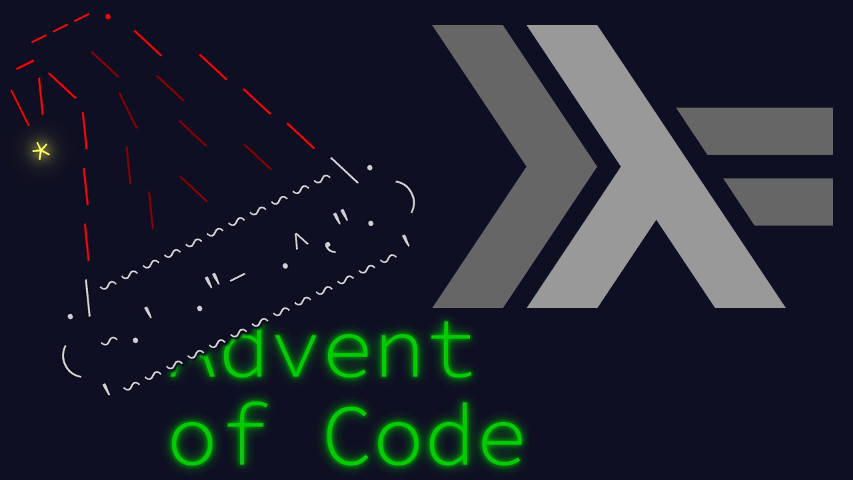Today’s Advent of Code problem, “Keypad Conundrum”, is a contender for best problem of the year. First off, not directly 2D grids-based. Then, an interesting implementation.1 An all-too predictable part 2 with a non-trivial solution. Took me quite some time, too.
Ok, let’s get going. Imports first, this being literate Haskell.
import Control.Applicative ((<|>))
import Control.Arrow ((&&&),first)
import Control.Lens ((^.),_1,_2)
import Control.Monad (guard,void,foldM)
import Data.Array (Array,listArray,(!),inRange,bounds,assocs)
import Data.Char (isDigit)
import Data.Function (fix)
import Data.List (find,nub)
import Data.List.Split (split,endsWith)
import Data.Maybe (mapMaybe)
import Data.MemoCombinators (memo3,bool,bits,list,char)
import Linear.V2 (V2(V2))
import qualified Data.Set as Set
type V = V2 IntThe entire problem revolves around keypads. Keypads to solve the in-story problem, and keypads to program robots to do so recursively. Our representation will include its layout, and the current position the robot that’s operating it is pointed at.
data Keypad = Keypad
{ kpPos :: V
, kpPad :: Array V (Maybe Char)
}
deriving (Eq,Ord)Two types of keypads are used: the most common is the directional keypad, and the last one in the chain is a numeric keypad. All have a static layout.
dirpad :: Keypad
dirpad = Keypad dirpadpos dirpadpad where
dirpadpad = listArray (V2 0 0,V2 1 2)
[ Nothing, Just '^', Just 'A'
, Just '<', Just 'v', Just '>'
]
dirpadpos = V2 0 2
numpad :: Keypad
numpad = Keypad numpadpos numpadpad where
numpadpad = listArray (V2 0 0,V2 3 2)
[ Just '7', Just '8', Just '9'
, Just '4', Just '5', Just '6'
, Just '1', Just '2', Just '3'
, Nothing, Just '0', Just 'A'
]
numpadpos = V2 3 2The main operation we can perform are those resulting from
directional keypad buttons: activate or move. Our result type is
Maybe to be able to express forbidden moves as
Nothing, and returns both the keypad’s new state and
potentially an outgoing action.
Invalid positions are refused at move time, so activation always works.
kpFollow :: Keypad -> Char -> Maybe (Keypad,Maybe Char)
kpFollow kp 'A' = do
let Just m = kpPad kp ! kpPos kp
Just (kp,Just m)
kpFollow kp d = do
let v = case d of
'^' -> V2 (-1) 0
'<' -> V2 0 (-1)
'v' -> V2 1 0
'>' -> V2 0 1
p' = kpPos kp + v
guard (inRange (bounds (kpPad kp)) p')
void (kpPad kp ! p') -- refuse the empty gap
Just (kp { kpPos = p' },Nothing)We’re going to want to combine those with the lock. Let’s define a class for all of those to follow.
class Ord s => StateMachine s where
stateGoal :: s -> Bool
stateFollow :: s -> Char -> Maybe (s,Maybe Char)
instance StateMachine Keypad where
stateGoal = const False
stateFollow = kpFollowThis allows to combine them, resulting in a combination that follows the same interface.
instance StateMachine s => StateMachine [s] where
stateGoal [s] = stateGoal s
stateGoal (_:ss) = stateGoal ss
stateFollow (s:ss) i = do
(s',mbM) <- stateFollow s i
(ss',m) <- maybe (Just (ss,Nothing)) (stateFollow ss) mbM
Just (s':ss',m)With the current definitions, our goal flag is always going to be
False, either directly from the keypads or transitively
from composition. Success is attained when the numeric keypad completes
the appropriate sequence. We can implement this as another
StateMachine.
newtype Sequence = Sequence String deriving (Eq,Ord)
instance StateMachine Sequence where
stateGoal (Sequence s) = null s
stateFollow (Sequence s) k = case s of
[] -> Nothing
(h:t) | k == h -> Just ((Sequence t),Nothing)
| otherwise -> NothingOops, this makes my combination operator work on a heterogeneous list, this won’t do. Adding a wrapper type and a bit of trivial plumbing.
data SM = SMKeypad Keypad | SMSequence Sequence deriving (Eq,Ord)
instance StateMachine SM where
stateGoal (SMKeypad kp) = stateGoal kp
stateGoal (SMSequence s) = stateGoal s
stateFollow (SMKeypad kp) i = first SMKeypad <$> stateFollow kp i
stateFollow (SMSequence s) i = first SMSequence <$> stateFollow s iYay. We’ve got all we need to reify a state for the entire chain of robots!
chain :: Int -> String -> [SM]
chain depth code =
replicate depth (SMKeypad dirpad) ++
[SMKeypad numpad,SMSequence (Sequence code)]We can now implement a good old BFS and search it!
bfs :: StateMachine s => [Char] -> s -> Int
bfs is s0 = go Set.empty [(s0,0)] where
go cl ((p,d):q)
| p `Set.member` cl = go cl q
| stateGoal p = d
| otherwise = go cl' (q ++ q') where
cl' = Set.insert p cl
q' = (,d+1) . fst <$> mapMaybe (stateFollow p) isAnd this solves part 1.
part1 :: [String] -> Int
part1 = sum . map complexity where
complexity code =
bfs "^<v>A" (chain 2 code) * read (takeWhile isDigit code)Part 2, what a surprise, extends the chain. A lot. Full search doesn’t cut it anymore. Back to the drawing board.
There’s a few things to notice to make it all faster.
First, full search on a single level is usually kind of wasteful. The
target keypad is not a maze, you can always go from a point to the other
by following a simple path of two segments, one horizontal and one
vertical. The controlling robot has to press A for each
move, so it’s obviously shorter overall not to move unless the current
direction is exhausted.
Let’s write a function to return the one or two reasonable paths from a position to the next. In the list monad, we’ll make deeper use of it shortly.
kpPathToPress :: Keypad -> Char -> Char -> [String]
kpPathToPress kp src dst = map (++ "A") $ nub $
let p1 = kpFind kp dst
p2 = kpFind kp src
V2 v h = p1 - p2
vPath = replicate (abs v) ("^ v" !! (signum v + 1))
hPath = replicate (abs h) ("< >" !! (signum h + 1))
hole = kpFindHole kp
notSame coord a b = (b - a) ^. coord /= 0
in (vPath ++ hPath) <$ guard (notSame _1 p1 hole || notSame _2 p2 hole) <|>
(hPath ++ vPath) <$ guard (notSame _2 p1 hole || notSame _1 p2 hole)This makes use of a bit of trivial support code:
kpFind :: Keypad -> Char -> V
kpFind kp c = kpFindRaw kp (Just c)
kpFindHole :: Keypad -> V
kpFindHole kp = kpFindRaw kp Nothing
kpFindRaw :: Keypad -> Maybe Char -> V
kpFindRaw kp c = p where
Just p = fst <$> find ((== c) . snd) (assocs (kpPad kp))I found the other relevant observation nicely hinted in the problem statement. Notice how it says you have to type multiple codes on the numeric keypads, but asks their complexity independently? How does this make sense?
It turns out it doesn’t make a difference whether they’re done
separately, in sequence, in reverse order or anything. Why? Because the
robots always reach a keypad pointing at the A button. And
they always complete a (shortest) sequence—at their level—on the
A button again. Plus, the code sequences end on
As themselves.
This makes the problem entirely decomposable into shorter subproblems, whose results can be cached.
Let’s outline a solve function, with recursion
abstracted away.
solve :: (Bool -> Int -> String -> Int) -> Bool -> Int -> String -> Intsolve rec numOrDir depth seq is intended to return the
length of a shortest sequence by the human operator to have a keypad,
type decided by numOrDir, isolated behind
depth layers of directional keypads, generate the key
sequence seq.
For a depth of 0, the human is typing the sequence directly, that’s easy enough.
solve _ _ 0 s = length sFor deeper keypads, we decompose the sequence into atomic cacheable chunks, generate the list of reasonable robotic arm paths that can yield it, keep the length of the smallest chain of human actions that yield it, and sum.
That length of the smallest chain of human actions conveniently
happens to be a solve result one level shallower.
solve rec isNum depth s =
sum $
map (
minimum .
map (rec False (depth - 1)) .
kpSeq (if isNum then numpad else dirpad)
) $
split (endsWith "A") sA bit of support code to generate those lists of sequences. In the
worst case, there’s two potential paths to go from a key to the next
(horizontal first or vertical first), so the typical recursion
patterns2 will be like
v<<A, two choices of ordering for a sequence of
meaningful length 3 since repeated presses are just more A
at the level above. Which is to say, the combinatorics here are more
than tractable, they’re small.
kpSeq :: Keypad -> [Char] -> [String]
kpSeq kp s =
foldM (\a bs -> (a ++) <$> bs) [] $
zipWith (kpPathToPress kp) ('A':s) sSprinkle a bit of memoization, and we’re ready to solve part 2.
part2 :: [String] -> Int
part2 = sum . map complexity where
complexity code =
fix (memo3 bool bits (list char) . solve) True 26 code
* read (takeWhile isDigit code)A wrapper to make sure we keep the bad-performance part 1 solution in scope, and we’re done.
main :: IO ()
main = interact $ show . (part1 &&& part2) . linesA puzzle without a dedicated parse function. How
refreshing too!
This concludes today’s code write-up. See you tomorrow!
This problem would have deserved a better solution than what I present here. Better, stricter typing, less static data hauled around. But I have real-life constraints too, and don’t want to get to solving in more than 24 hours, so at some point I dropped the niceties and just shoved
Chars around. A pity. And I probably won’t ever get back to it. Oh well.↩︎The utmost typical one is just
A.↩︎



